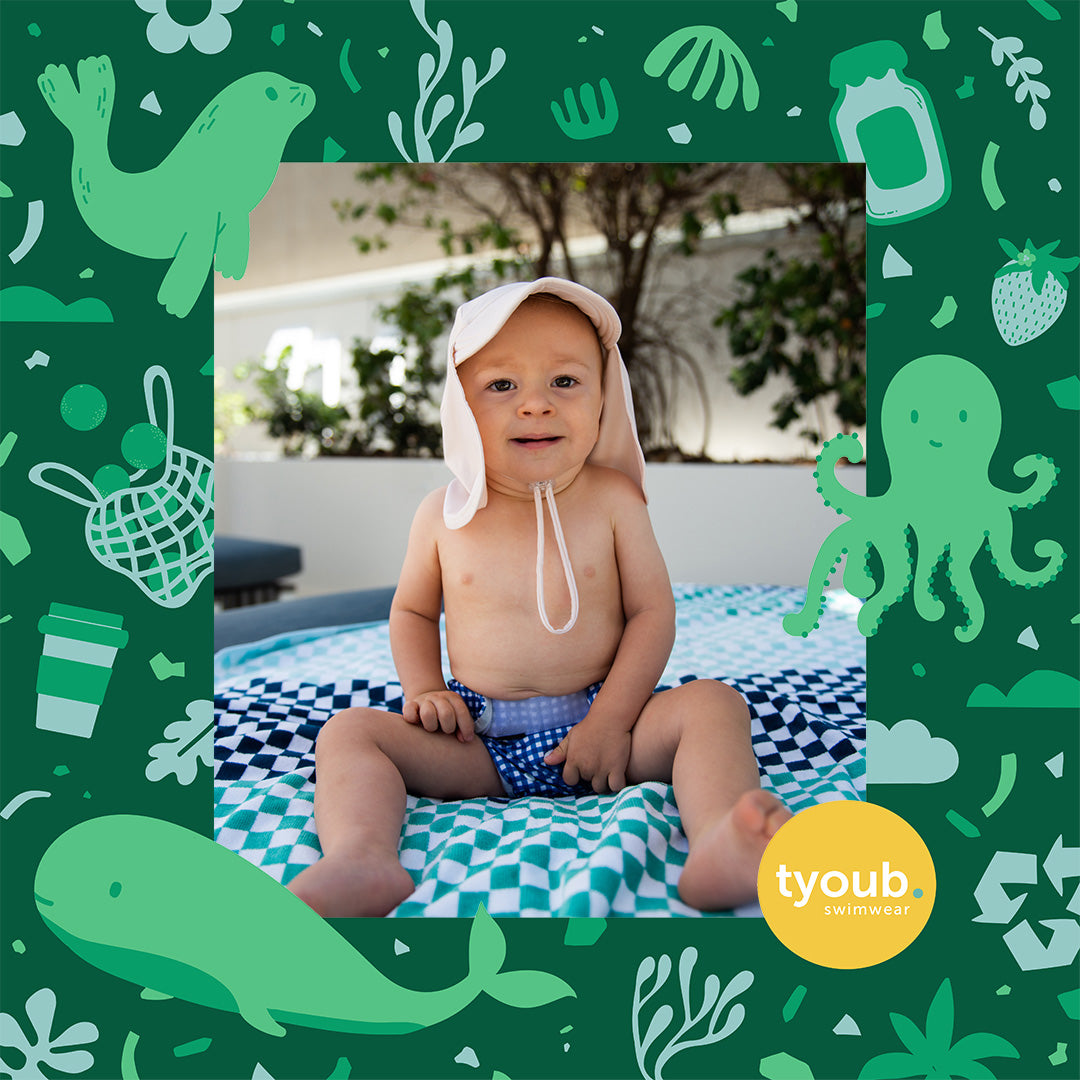Accessories
Check out our full lineup of yoga accessories to help you with your daily meditation practice and fitness goals...
Try our new Cork Yoga Brick for soft but solid support
Check out our full lineup of yoga accessories to help you with your daily meditation practice and fitness goals...

Tiny Tots, Big Threats: Exploring Infant Health Risks in a Plastic World
5 min read
We're living in the Plasticene era, where plastics have become ubiquitous, infiltrating every aspect of our lives since the 1950s. Initially marketed as a boon, plastics were hailed for their convenience and durability. However, recent revelations show the dark side of this reliance as microplastics infiltrate our water and food, suggesting we're inadvertently consuming them.
With plastic production set to double by 2040, questions about its safety and the effects of its chemical additives loom large. EARTHDAY.ORG's primer on plastics and microplastics, backed by numerous studies, sheds light on the concerning findings regarding their ingestion, potential bioaccumulation, and health implications.
The collective results are worrisome, urging independent research to prove plastic safety, and advocating for the precaution using them until then. It's time to critically assess the true cost of our plastic dependence. Find the full research article here.
We’ve summarised some of these findings and how they impact our little one’s wellbeing and overall health concerns.
Problem: Microplastics in our homes = Solution: Vacuum, dust and mop often!
Common plastics found in and around us every day are:
- Polyester in our clothing,
- Polyamide typically in textiles,
- Polyvinyl used in floor varnishes,
- Polyurethane used in coatings on furniture, spill proof and
- Polyethylene in food containers and reusable zip lock bags.
Microplastics are widespread, found all over the planet, including in remote areas, with babies and children most likely encountering them in their homes where they spend much of their time.
A 2022 study conducted across 29 countries and 108 homes found various types of microplastics in dust samples, including polyester, polyamide, polyvinyl, polyurethane, and polyethylene, with vacuuming identified as the best way to mitigate exposure.
While exposure to microplastics in homes was deemed 'low risk,' the overall exposure levels were not fully studied, highlighting the need for further research into the impact of microplastics on health.
Problem: Toys, teethers, utensils and feeding = Solution: start with natural rubber, silicone and glass, look for wood options and ceramic bowls, if you there is no other option get the best quality plastic and once it starts to wear throw it away (responsibly and possibly recycle)
Mouthing, crawling & teething are what babies and infants love to do!
Everything goes straight into their mouths – this is how babies decode the world around them. Finding out if the object is edible or not, hard or soft, hot or cold, and ‘tasting’ sweet, sour, bitter and salty flavours. Most of what they put in their mouths is plastic, typically toys and teethers.
A whopping 90% of toys are made of plastic, two components commonly used are Polyvinyl chloride (PVC) and Bisphenol A (BPA) – these are currently NOT banned in USA and are known endocrine disruptors that interfere with the body’s hormone system, creating high levels of estrogen.
Plastic baby bottles account for 80% of all baby bottles around the world, the vast majority of which are made of a plastic called polypropylene. Heating baby bottles in the microwave has been shown to increase an infants exposure to microplastics.
Similar levels have also been noted in plastic sippy cups, hard bibs, utensils and feeding bowls. Scientists also detected microplastics in expressed breast milk which had been stored in disposable storage bags.
Problem: Baby clothing and bedding = Solution: buy cotton and organic where you can!
A staggering 69% of clothing fabrics are made from oil-based plastics like polyester, acrylics, nylon, and spandex, which have qualities like quick drying and water resistance but can also trap moisture and not breathe well.
Synthetic materials in clothing, bedding, furniture, cots, and mattresses generate microplastics and microfibers, with thousands released into water every time they are washed. They are also released into the air and we breath them in!
Globally, washing machines deposit 500,000 tons of microfibers into oceans annually, contributing to 35% of microplastics in oceans.
Research is needed to understand the health effects of babies and children inhaling or ingesting microplastics, which can accumulate in living organisms and affect marine life. Marine biologists have long reported finding plastics in fish and sea birds!
Microfibers are coated with toxic chemicals like azo dyes, fluorinated compounds (PFCs), PFAS, PBPA, and phthalates, which have been linked to health issues including cancer and immune suppression.
Testing found fluorine, an indicator of PFAS presence, in all 34 samples of baby and children's textile products. Exposure to phthalates during pregnancy has been associated with a 12-16% increased risk of preterm birth.
Problem: Playgrounds made with old tires! = Solution: play on grass or sand where possible!
Styrene butadiene rubber (SBR), also known as crumb rubber, sourced mainly from discarded tires, finds widespread use in constructing sports facilities, playgrounds, and recreational areas.
Despite its popularity for creating resilient playground surfaces, concerns arise regarding its potential to release chemicals and microplastic particles into the environment, highlighted in reports by the California Office of Environmental Health Hazard Assessment (OEHHA) in 2007, 2010, and 2016.
Studies, including one by The Open University of the Netherlands in 2017, have estimated tires to contribute significantly to global ocean microplastic pollution, with varying percentages reported by different organizations.
While the US Environmental Protection Agency (EPA) in 2019 concluded no increased risk from crumb rubber fields, acknowledging data gaps, the European Commission initiated measures in September 2023 to restrict intentional microplastic additions to products, including the use of crumb rubber in sports fields and playgrounds.
Where / What / Wear to next?
We need to reduce our dependency on plastics, to curb plastic production. Specifically in the single-use plastics which accounts for 50% of all plastic produced.
Recycling is not the solution or silver bullet to our plastic burden – it’s too expensive, it doesn’t solve the issue of microplastics and the sorting all the different types of plastics is difficult, so it ends in landfill or being burnt.
We need better research and funding into the health implications for people, with attention on unborn babies, neonates and infants. They are smaller than adults and by virtue of their environmental exploration they naturally have a higher exposure risk to both plastic, chemicals and mircoplastics.
End Greenwashing with all the misleading claims and untruths, must be called out! Unfortunately, it is often around recycled plastics and these claims need to be substantiated - please see our Sustainability pledge.
The plastic industry and manufacturers need to be transparent about their internal research on human health impacts and global climate through the release of greenhouse gas. It begs the question; What are they not telling us?
For more reading and how to get involved please head over to Earth Day!
Premium. Ethical. Sustainable. Kids. Swimwear.
Tyoub, eco-friendly swimwear brand based in Melbourne, Australia. Offering reusable swim nappies for toddlers and babies. The best bathers and swim togs for children. Year round swim essentials to help parents navigate weekly swimming lessons and hassle free holidays. Conscious swimwear made with recycled polyester motivated by marine conservation.

